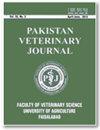求助PDF
{"title":"具有抗氧化和抗炎活性的酚类衍生物:体外和体内研究","authors":"M. Aqeel","doi":"10.29261/pakvetj/2019.052","DOIUrl":null,"url":null,"abstract":"Received: Revised: Accepted: Published online: January 10, 2019 January 29, 2019 January 30, 2019 April 06, 2019 Polyphenols are widely distributed in nature having broad spectrum of biological activities. Most of the biological effects produced by polyphenols are largely attributed to their anti-inflammatory and antioxidant potential. The current research work describes the anti-inflammatory and antioxidant potential of newly synthesized phenolic derivatives (T2, T5, T6, T7 & T8) through in silico, in vitro and in vivo approach. The docking studies were performed against NADPH oxidase (PDB ID 3A1F-) and cyclooxygenase (COX-2 with PDB ID 5KIR Homosapien) using in silico techniques. Amongst phenolic derivatives (T2, T5, T6, T7 &T8) T2 and T6 exhibited maximum binding affinity with target protein NADPH oxidase (6.2 and -6.3 Kcal/mol respectively). However, in case of COX-2 as target protein, all the five newly synthesized phenolic derivatives showed encouraging results. In particular, T2 and T8 with binding affinity values -7.9 Kcal/mol and -8.0 Kcal/mol respectively which are promising than Ibuprofen with binding affinity -6.6 Kcal/mol. Then in vitro antioxidant potential of phenolic derivatives was analyzed through total reducing power, total antioxidant capacity and DPPH (1, 1-diphenyl2picryl-hydrazyl) assay. T2 and T6 showed antioxidant potential with IC50 values of 25.03μg/ml and 37.21 μg/ml respectively as compared to 15.14 μg/ml with respect to ascorbic acid. In vivo anti-inflammatory potential was determined through carrageenan induced paw edema which resulted in T2 with promising percentage edema inhibition (68.64±3.34) as compare to standard piroxicam (83.84±3.87). Amongst all phenolic derivatives T2 has promising results in in silico, in vitro and in vivo studies. ©2019 PVJ. All rights reserved","PeriodicalId":19845,"journal":{"name":"Pakistan Veterinary Journal","volume":" ","pages":""},"PeriodicalIF":3.8000,"publicationDate":"2019-10-01","publicationTypes":"Journal Article","fieldsOfStudy":null,"isOpenAccess":false,"openAccessPdf":"","citationCount":"0","resultStr":"{\"title\":\"Phenolic Derivatives with Antioxidant and Anti-Inflammatory Activities: An in Silico, in vitro and in vivo Study\",\"authors\":\"M. Aqeel\",\"doi\":\"10.29261/pakvetj/2019.052\",\"DOIUrl\":null,\"url\":null,\"abstract\":\"Received: Revised: Accepted: Published online: January 10, 2019 January 29, 2019 January 30, 2019 April 06, 2019 Polyphenols are widely distributed in nature having broad spectrum of biological activities. Most of the biological effects produced by polyphenols are largely attributed to their anti-inflammatory and antioxidant potential. The current research work describes the anti-inflammatory and antioxidant potential of newly synthesized phenolic derivatives (T2, T5, T6, T7 & T8) through in silico, in vitro and in vivo approach. The docking studies were performed against NADPH oxidase (PDB ID 3A1F-) and cyclooxygenase (COX-2 with PDB ID 5KIR Homosapien) using in silico techniques. Amongst phenolic derivatives (T2, T5, T6, T7 &T8) T2 and T6 exhibited maximum binding affinity with target protein NADPH oxidase (6.2 and -6.3 Kcal/mol respectively). However, in case of COX-2 as target protein, all the five newly synthesized phenolic derivatives showed encouraging results. In particular, T2 and T8 with binding affinity values -7.9 Kcal/mol and -8.0 Kcal/mol respectively which are promising than Ibuprofen with binding affinity -6.6 Kcal/mol. Then in vitro antioxidant potential of phenolic derivatives was analyzed through total reducing power, total antioxidant capacity and DPPH (1, 1-diphenyl2picryl-hydrazyl) assay. T2 and T6 showed antioxidant potential with IC50 values of 25.03μg/ml and 37.21 μg/ml respectively as compared to 15.14 μg/ml with respect to ascorbic acid. In vivo anti-inflammatory potential was determined through carrageenan induced paw edema which resulted in T2 with promising percentage edema inhibition (68.64±3.34) as compare to standard piroxicam (83.84±3.87). Amongst all phenolic derivatives T2 has promising results in in silico, in vitro and in vivo studies. ©2019 PVJ. All rights reserved\",\"PeriodicalId\":19845,\"journal\":{\"name\":\"Pakistan Veterinary Journal\",\"volume\":\" \",\"pages\":\"\"},\"PeriodicalIF\":3.8000,\"publicationDate\":\"2019-10-01\",\"publicationTypes\":\"Journal Article\",\"fieldsOfStudy\":null,\"isOpenAccess\":false,\"openAccessPdf\":\"\",\"citationCount\":\"0\",\"resultStr\":null,\"platform\":\"Semanticscholar\",\"paperid\":null,\"PeriodicalName\":\"Pakistan Veterinary Journal\",\"FirstCategoryId\":\"97\",\"ListUrlMain\":\"https://doi.org/10.29261/pakvetj/2019.052\",\"RegionNum\":3,\"RegionCategory\":\"农林科学\",\"ArticlePicture\":[],\"TitleCN\":null,\"AbstractTextCN\":null,\"PMCID\":null,\"EPubDate\":\"\",\"PubModel\":\"\",\"JCR\":\"Q1\",\"JCRName\":\"VETERINARY SCIENCES\",\"Score\":null,\"Total\":0}","platform":"Semanticscholar","paperid":null,"PeriodicalName":"Pakistan Veterinary Journal","FirstCategoryId":"97","ListUrlMain":"https://doi.org/10.29261/pakvetj/2019.052","RegionNum":3,"RegionCategory":"农林科学","ArticlePicture":[],"TitleCN":null,"AbstractTextCN":null,"PMCID":null,"EPubDate":"","PubModel":"","JCR":"Q1","JCRName":"VETERINARY SCIENCES","Score":null,"Total":0}
引用次数: 0
引用
批量引用
Phenolic Derivatives with Antioxidant and Anti-Inflammatory Activities: An in Silico, in vitro and in vivo Study
Received: Revised: Accepted: Published online: January 10, 2019 January 29, 2019 January 30, 2019 April 06, 2019 Polyphenols are widely distributed in nature having broad spectrum of biological activities. Most of the biological effects produced by polyphenols are largely attributed to their anti-inflammatory and antioxidant potential. The current research work describes the anti-inflammatory and antioxidant potential of newly synthesized phenolic derivatives (T2, T5, T6, T7 & T8) through in silico, in vitro and in vivo approach. The docking studies were performed against NADPH oxidase (PDB ID 3A1F-) and cyclooxygenase (COX-2 with PDB ID 5KIR Homosapien) using in silico techniques. Amongst phenolic derivatives (T2, T5, T6, T7 &T8) T2 and T6 exhibited maximum binding affinity with target protein NADPH oxidase (6.2 and -6.3 Kcal/mol respectively). However, in case of COX-2 as target protein, all the five newly synthesized phenolic derivatives showed encouraging results. In particular, T2 and T8 with binding affinity values -7.9 Kcal/mol and -8.0 Kcal/mol respectively which are promising than Ibuprofen with binding affinity -6.6 Kcal/mol. Then in vitro antioxidant potential of phenolic derivatives was analyzed through total reducing power, total antioxidant capacity and DPPH (1, 1-diphenyl2picryl-hydrazyl) assay. T2 and T6 showed antioxidant potential with IC50 values of 25.03μg/ml and 37.21 μg/ml respectively as compared to 15.14 μg/ml with respect to ascorbic acid. In vivo anti-inflammatory potential was determined through carrageenan induced paw edema which resulted in T2 with promising percentage edema inhibition (68.64±3.34) as compare to standard piroxicam (83.84±3.87). Amongst all phenolic derivatives T2 has promising results in in silico, in vitro and in vivo studies. ©2019 PVJ. All rights reserved


